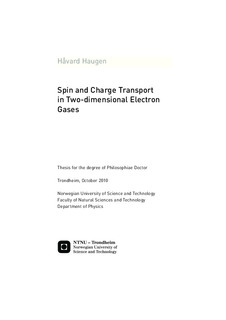| dc.contributor.author | Haugen, Håvard | nb_NO |
| dc.date.accessioned | 2014-12-19T13:16:44Z | |
| dc.date.available | 2014-12-19T13:16:44Z | |
| dc.date.created | 2011-06-07 | nb_NO |
| dc.date.issued | 2010 | nb_NO |
| dc.identifier | 420913 | nb_NO |
| dc.identifier.isbn | 978-82-471-2379-9 (printed ver.) | nb_NO |
| dc.identifier.isbn | 978-82-471-2380-5 (electronic ver.) | nb_NO |
| dc.identifier.uri | http://hdl.handle.net/11250/246416 | |
| dc.description.abstract | With the continuing demand for miniaturisation from the electronics industry, it becomes increasingly important to understand the physical behaviour of nanometre sized conductors. State-of-the-art transistors have typical length scales of the order a few tens of nanometres. On these mesoscopic scales, quantum effects become important in certain semiconductor systems at low temperature, or in the case of the newly discovered graphene even at room temperature. The quantum effects can significantly alter the electronic behaviour of a device. Quantum transport on the mesoscopic scale is also interesting from a fundamental point of view, as it allows us to study the crossover between the quantum and classical regimes of physics.
The two-dimensional electron gases studied in this thesis can be created at the interface between a semiconductor and another semiconductor or an insulator. Graphene is another twodimensional conductor which holds great promises for use in electronics, due to high mobilities, gate controllable doping, and its intrinsic two-dimensionality.
In the first two papers of this thesis [1, 2] we investigate spin transport in graphene. The first paper [1] suggests a way of inducing a significant spin polarisation in the non-magnetic material, while the second paper [2] examines the role of the spin-orbit interaction in highly doped graphene.
The last two papers [3, 4] study the non-local electronic signal that can be induced between two normal contacts in the presence of a superconductor. The physical process responsible for this signal, crossed Andreev reflection, has been suggested as a candidate for generating entangled electrons in a solid state device. While experimentally such a signal has only been observed beyond linear response or in the presence of interactions, we show that it is possible to generate this type of signal also in linear response.
| nb_NO |
| dc.language | eng | nb_NO |
| dc.publisher | Norges teknisk-naturvitenskapelige universitet, Fakultet for naturvitenskap og teknologi, Institutt for fysikk | nb_NO |
| dc.relation.ispartofseries | Doktoravhandlinger ved NTNU, 1503-8181; 2010:200 | nb_NO |
| dc.relation.haspart | Haugen, Havard; Huertas-Hernando, Daniel; Brataas, Arne. Spin transport in proximity-induced ferromagnetic graphene. Physical Review B. Condensed Matter and Materials Physics. (ISSN 1098-0121). 77(11): 115406, 2008. <a href='http://dx.doi.org/10.1103/PhysRevB.77.115406'>10.1103/PhysRevB.77.115406</a>. | nb_NO |
| dc.relation.haspart | Haugen, H.; Brataas, A.. Spin transport in doped graphene. . | nb_NO |
| dc.relation.haspart | Haugen, Havard; Huertas-Hernando, Daniel; Brataas, Arne; Waintal, Xavier. Crossed Andreev reflection versus electron transfer in three-terminal graphene devices. Physical Review B. Condensed Matter and Materials Physics. (ISSN 1098-0121). 81(17): 174523, 2010. <a href='http://dx.doi.org/10.1103/PhysRevB.81.174523'>10.1103/PhysRevB.81.174523</a>. | nb_NO |
| dc.relation.haspart | Haugen, H.; Brataas, A.; Waintal, X.; Bauer, G. E. W.. Focused crossed Andreev reflection. Europhysics letters. (ISSN 0295-5075). 93(6): 67005, 2011. <a href='http://dx.doi.org/10.1209/0295-5075/93/67005'>10.1209/0295-5075/93/67005</a>. | nb_NO |
| dc.title | Spin and Charge Transport in Two-dimensional Electron Gases | nb_NO |
| dc.type | Doctoral thesis | nb_NO |
| dc.contributor.department | Norges teknisk-naturvitenskapelige universitet, Fakultet for naturvitenskap og teknologi, Institutt for fysikk | nb_NO |
| dc.description.degree | PhD i fysikk | nb_NO |
| dc.description.degree | PhD in Physics | en_GB |
